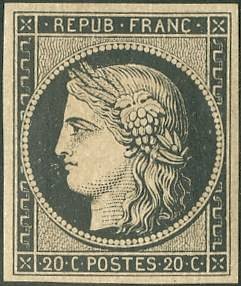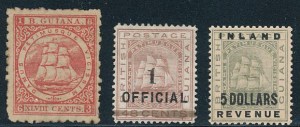Most American collectors who wish to venture past the home country predilection for collecting only United States stamps learn about the stamps of the British Commonwealth. Some go to Germany and Area and some few more to France and Colonies. But one of the major collecting areas is the Italian area. Italian philately has it all. Italy confederated in the late Nineteenth Century like Germany and so has numerous State issues such as Tuscany and Roman States that were issued by political entities that were later unified by Garibaldi. Italian philately has the intrinsic interest of Italy proper with thousands of well designed stamps with numerous difficult to find varieties only some of which are listed by the Scott catalog (most of the rest are listed by the specialized Italian catalog-Sassone). The airmails of Italy are very popular as are the postage dues and parcel posts. Italy has WWI and WWII issues including Occupation stamps that are as interesting as Germany's and the Italian Colonies
Monthly Archives: November 2019
- Posted November 30, 2019in NewsRead more »
- Posted November 26, 2019in NewsRead more »
The greatest impediment to a smaller country's philatelic popularity is rarities. Collectors, when they move outside the philately of their home country, want attractive stamps and they want a collection that is completable for a reasonable expenditure of time and money. British Guiana has always had this philatelic cross to bear. The stamps are interesting, well designed and hard to find. But the rarest stamp in the world, the one cent magenta, is from British Guiana as are the Cotton Reels and the first page in the British Guiana specialty album would cost you about $2 million to complete- even if you could get the British Guiana out of the estate of John DuPont, who died in prison in 2010 after murdering a wrestler on his property in 1997. British Guiana was originally settled by the Dutch and would be included in the philately of Netherlands Antilles if the Dutch hadn't ceded sovereignty to the British during the Napoleonic wars. For years, British Guiana was in essence a huge sugar
- Read more »
Antigua was one of the first islands discovered by Christopher Columbus in 1493. For over 150 years after that native Caribs resisted colonization from the Spanish and as the island was small and had little to offer in the way of gold and silver, the Spanish left it alone. By the mid seventeenth century, the British were colonizing most of the West Indian islands, turning them into slave plantations for the production of tobacco and sugar. The purpose of these islands and what went on in Antigua was well known in Great Britain and it was the treatment of the African slaves in these island that created the British abolitionist movement. But the acceptance of the West Indian slave economy was so ubiquitous in England that as a plot twist in Mansfield Park (1812), Jane Austen has Sir Thomas Bertram leave for eighteen months to go look into his mismanaged slave plantations in Antigua (throughout the book Sir Thomas is presented as a good and kindly character, which he was, except to his slaves).
- Posted November 16, 2019in NewsRead more »
The philately of the British Commonwealth is characterized by specialization by reigns. Some collectors attempt it all but most collectors specialize either by country or by the issues of the differing reigning monarchs which is another way of collecting by era. Queen Victoria was on the first postage stamps and reigned (philatelically) from 1840-1901. King Edward VII followed (1901-1910), then George V (1910-1936), Edward VIII (a philatelic nonentity), George VI (1936-1952), and Queen Elizabeth II (1952-current). 2013 will celebrate Elizabeth's 61st philatelic year matching Queen Victoria. To have had only five monarchs on your stamps in 170 years is a monument of longevity and stability.
- Posted November 13, 2019in NewsRead more »
Great stamp collections are made by people who share one trait - consistency. Sure, money helps make a great collection. It would be hard to have rare stamps without some monetary outlay. And good fortune (when it happens to you-luck when it happens to someone else-and dumb luck when to a person who you don't like) plays a role too. One has to be lucky sometimes to find the just right item for a specialized collection. But consistency is the overriding feature that the most successful philatelists share. First, collectors need consistency of approach. They need to define their collecting carefully and be aware of the items that they need in their specialized area. They do the study and the research to determine what is available and what the approximate price level will be. They are realistic with their resources. A collector with modest resources can assemble a wonderful collection in a field where the price points are more modest and the amount of material less vast-Guam comes to mind.
- Posted November 09, 2019in NewsRead more »
 For the first 92 years that the United States issued postage stamps the themes were either famous politicians or historical events. In 1939 that changed and the United States issued its first stamp with a nonpolitical theme-baseball. The origins of baseball are not well known. The Abner Doubleday myth was created in the early part of the twentieth century but the truth is that baseball is an American rendering of the English game of rounders and it grew up in an informal way during the early to mid nineteenth century. By about 1880 the rules looked pretty much like they do today. In the days before active professional football and basketball, baseball reigned supreme as our national past time. The popularity of baseball is founded in much the same way as the joys of philately. They are passed on from parents to children and often become part of the lifelong bonding that exists between us and our families even after our parents are gone. Many collectors remember their fathers showing them
For the first 92 years that the United States issued postage stamps the themes were either famous politicians or historical events. In 1939 that changed and the United States issued its first stamp with a nonpolitical theme-baseball. The origins of baseball are not well known. The Abner Doubleday myth was created in the early part of the twentieth century but the truth is that baseball is an American rendering of the English game of rounders and it grew up in an informal way during the early to mid nineteenth century. By about 1880 the rules looked pretty much like they do today. In the days before active professional football and basketball, baseball reigned supreme as our national past time. The popularity of baseball is founded in much the same way as the joys of philately. They are passed on from parents to children and often become part of the lifelong bonding that exists between us and our families even after our parents are gone. Many collectors remember their fathers showing them - Posted November 06, 2019in NewsRead more »
Of all the first issue imperfs of all the major countries, Austrian first issues are among the most interesting and certainly among the most inexpensive. The first stamp in yellow and the second stamp in black are the scarcest, selling for about $20 each (and the balance of the set (Scott #3-5) can be had for about $5). A similar set was issued for the Austrian administered province of Lombardy-Venetia which includes the large portion of Northern Italy which was part of the Austro-Hungarian Empire at this period.
The first issues of Austria may be the most minutely specialized in the world and this is helped by the fact that the stamps are so modestly priced that they are the easiest classic stamps to collect in a specialized way on an ordinary budget. The specialization possibilities of these stamps are vast. Collectors collect by shade as they do for most other classics which went through many - Posted November 02, 2019in NewsRead more »
 The first stamp issued in the world portrayed the ruling monarch of the issuing country (Great Britain Penny black). After that it became protocol to use the portrait of the ruler of a country on postage stamps or in the case of the United Sates to use a deceased president or statesman. Some countries without a strong national ruler might use a national symbol as in the case of the first issues of Canada which show a beaver. Many European countries, such as Russia and many of the German States showed the Coat of Arms of the ruling family. But France began what what was to be a tradition on most of her nineteenth century stamps by using a allegorical image, which on the first stamps was the goddess Ceres, the deity of agriculture who also represented prosperity. France political life was troubled throughout the nineteenth century with Kings being replaced by Emperors which were superseded by Republican forms of government before going back to monarchy. Perhaps this is why for her first stamp
The first stamp issued in the world portrayed the ruling monarch of the issuing country (Great Britain Penny black). After that it became protocol to use the portrait of the ruler of a country on postage stamps or in the case of the United Sates to use a deceased president or statesman. Some countries without a strong national ruler might use a national symbol as in the case of the first issues of Canada which show a beaver. Many European countries, such as Russia and many of the German States showed the Coat of Arms of the ruling family. But France began what what was to be a tradition on most of her nineteenth century stamps by using a allegorical image, which on the first stamps was the goddess Ceres, the deity of agriculture who also represented prosperity. France political life was troubled throughout the nineteenth century with Kings being replaced by Emperors which were superseded by Republican forms of government before going back to monarchy. Perhaps this is why for her first stamp




